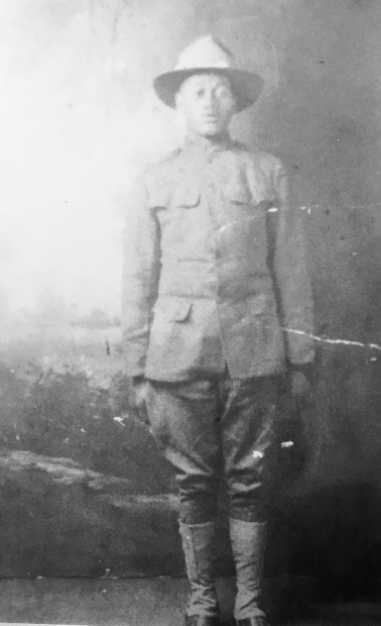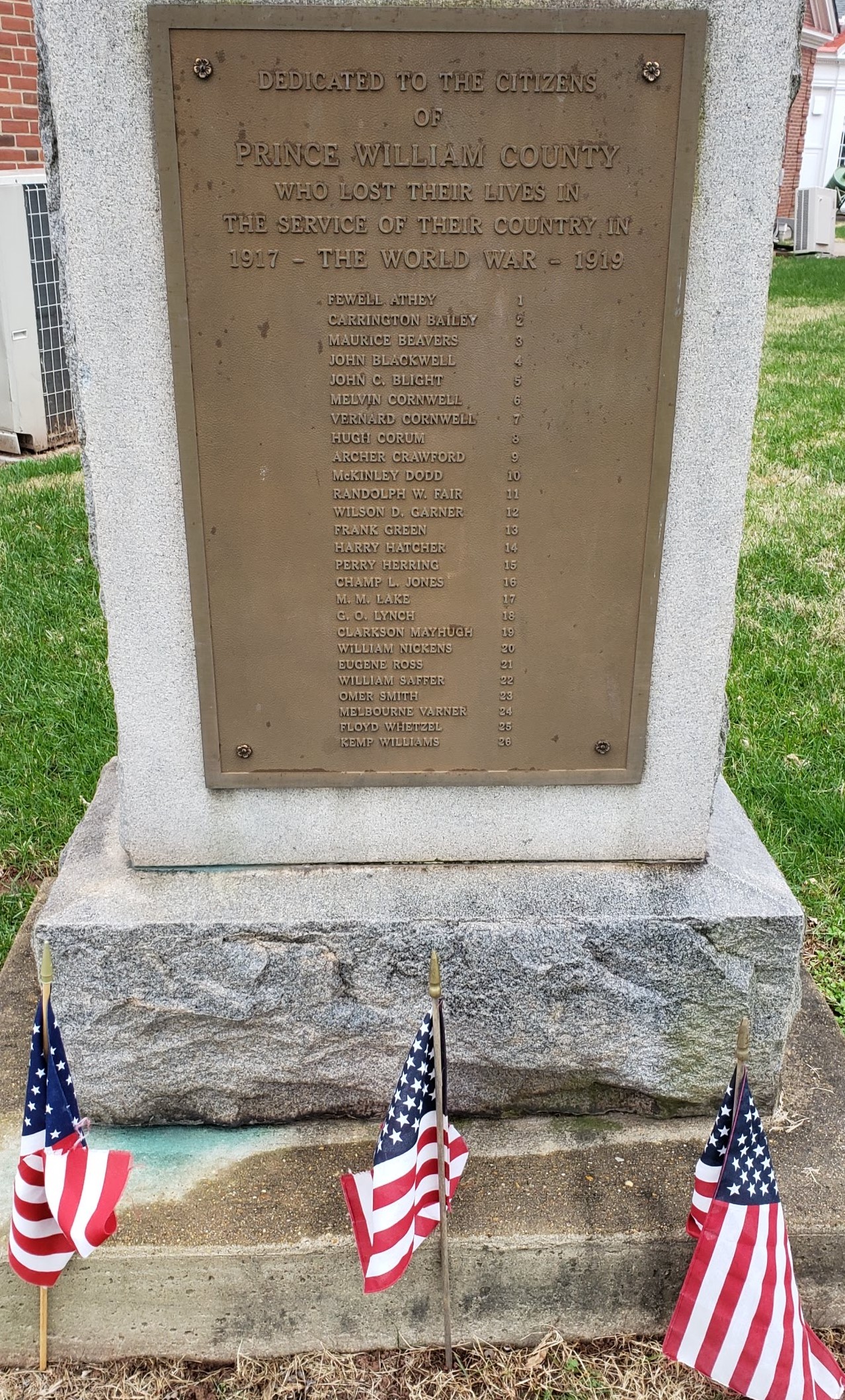Private Harry W. Hatcher

- Unit: 93rd Division, 372nd Infantry Regiment, Company E
- Date of Birth: April 24, 1893
- Entered the Military: October 26, 1917
- Date of Death: October 8, 1918
- Hometown: Waterfall, Virginia
- Place of Death: Monthois, France
- Cemetery: Plot A, Row 27, Grave 10. Meuse-Argonne American Cemetery, Romagne-Sous-Montfaucon, France
Rocky Run Middle School
2017–2018
Early Life
On April 24, 1893, Harry W. Hatcher was born in Waterfall, Virginia, the second oldest of George and Mary Hatcher’s seven children. His mother taught Hatcher and his siblings to read and write on the family farm in Gainesville, Virginia, where he worked as a farm laborer until the age of 22.
In March 1915, Hatcher married Bertha Roy in Washington, D.C. and they settled in Theological Seminary, Virginia, near present-day Alexandria. Hatcher began work as a laborer at the Potomac Yards during which time he registered for the draft. On the registration card he listed himself of African American descent, with a tall build, brown eyes, and black hair. Hatcher claimed exemption from the draft on the grounds that he provided financial support for both his wife and his mother. Hatcher’s claim of exemption was denied, and he was drafted into the U.S. military on October 26, 1917.


Military Experience
Hacher began his military training at Camp Stewart in Newport News, Virginia, in December 1917. As an African American man, he trained in segregated facilities and had only limited contact with the white soldiers training nearby.
After two months training, Hatcher’s unit, the 93rd Division, 372nd Infantry Regiment, Company E shipped out on the USAT Susquehanna bound for Europe on March 30, 1918, and arrived at the port of St. Nazaire, France on April 14. For the first week of his time in France, Hatcher’s unit worked as stevedores unloading ships of American supplies arriving in France.
In late April, Hatcher’s unit was informed that they would be fighting alongside the 157th French Division. Being sent into combat was unusual since 80% of the 200,000 African Americans in World War I served in labor or supply units. The remaining 20% (approximately 40,000 men) were sent into combat but not with U.S. forces because the American government and many of its white citizens were uncomfortable with the idea of African Americans fighting alongside whites. The French, on the other hand, had no such reservations. They welcomed the 372nd Infantry Regiment in battle against the Germans.
One African American soldier expressed relief at being able to serve in combat saying, “we were proud that the 372nd did not suffer the fate of most other Negro units in France. We did not come overseas to unload supplies or clean barracks. We were trained infantrymen – nothing else – and we conducted ourselves like soldiers.”
Hatcher’s unit moved from Saint-Nazaire to Condé en Barrois, France on April 23 to begin a month of training for combat under the watchful eye of French officers. Since Hatcher’s unit served with the French, they received French equipment including the famous Blue Adrian helmets worn by French soldiers. By all accounts, the French soldiers treated them equally.
Hatcher’s unit left training to join the fighting in July 1918 arriving in the Argonne Forest on July 16. The Battle of Meuse-Argonne was the final major fight of World War I and is one of the largest battles in U.S. military history. In early October, Hatcher’s unit was ordered to take the town of Monthois, a small village in eastern France with fewer than 2,000 citizens.
Despite its small population, Monthois was important because the Germans controlled the railroad that went through the town and used it to supply their army. The Germans fought fiercely to keep Monthois and hand-to-hand combat between the American and German forces was frequent. The 372nd Infantry Regiment entered the town on October 2, but the Germans drove them back to a position just outside of Monthois.
A U.S. Army field message reported that the battle was so fierce that only 120 of the 600 men who started the battle were still able to fight. Infantry Captain W. F. Swift said that the majority of the men were “scattered, gassed and wounded, and in need of picks and shovels.” Hatcher was injured in the battle for Monthois and on October 8, 1918 he died from his wounds.



Eulogy
Hatcher’s family was informed of his passing in the months following his death. In 1921, his family made the decision to leave his body buried in France. In the 1930s, Hatcher’s body was re-interred at the Meuse-Argonne American Cemetery with more than 14,000 other Americans who died serving their country in World War I.
Hatcher’s family was invited to visit his grave site as part of the U.S. government’s Gold Star Mothers Pilgrimage program. The program was a way for families to travel to Europe to pay respects at their loved ones’ grave sites. Hatcher’s mother, Mary, had hoped to make the trip stating, “I would dearly love to visit my darling son’s grave who was such a dear boy to me and loved by all who knew him.” Despite her desire to go and numerous opportunities extended by the government, Mary Hatcher was unable to visit her son’s grave overseas due to continuing health problems.
Back home in Virginia, Hatcher’s name is listed on the memorials in both Prince William County where he was born, as well as Fairfax County where he lived when drafted into the U.S. Army. Hatcher’s name is listed with other African Americans who died in World War I on a tablet whose names are segregated by race.
Honors for the 372nd Regiment Infantry
For their bravery in battle, the surviving members of 372nd Regiment Infantry received the Croix de Guerre from the French government. Additionally, a memorial honoring the 372nd Infantry Regiment was created and dedicated to the memory of those died in the battle for Monthois.


Reflection
Bibliography
93rd Division; Records of the American Expeditionary Forces (World War I), Records of Combat Divisions, 1917-1919, Record Group 120 (Box 1); National Archives at College Park, College Park, MD.
93rd Division; Records of the American Expeditionary Forces (World War I), Records of Combat Divisions, 1917-1919, Record Group 120 (Box 3); National Archives at College Park, College Park, MD.
93rd Division; Records of the American Expeditionary Forces (World War I), Records of Combat Divisions, 1917-1919, Record Group 120 (Box 6); National Archives at College Park, College Park, MD.
The Americans Advance Northwest of Verdun: American Negro infantryman advancing toward the front in the Argonne along a screened in highway. Photograph. 1918. National Archives and Records Administration (111-SC-25042). Image.
American Colored Troops in France: Machine Gun Instruction. Photograph. 1918. National Archives and Records Administration (165-WW-127-108). Image.
“Biographies of the Men of Fairfax County Who Died in World War I.” Accessed December 1, 2018. www.honorfairfaxcemeteries.org/wp-content/uploads/2017/03/Bios-of-WWI-soldiers.pdf.
Black, Lowell D., The Negro Volunteer Militia National Guard, 1870-1954, PhD. Dissertation, The Ohio State University, 1976.
District of Columbia, Compiled Marriage Index 1830-1921. ancestry.com.
“Harry Hatcher.” American Battle Monuments Commission. Accessed June 26, 2018. www.abmc.gov/node/326586#.XA1SHGhKjIU.
Harry Hatcher World War I Burial Case File; Correspondence, Reports, Telegrams, Applications and Other Papers relating to Burials of Service Personnel, Records of the Quartermaster General’s Office, 1915-1935, Record Group 92; National Archives and Records Administration – St. Louis.
Hatcher Family Photographs. 1915-1917. Courtesy of the Hatcher Family.
Johnson II, William P. “Where Honor is Due: Fairfax County Casualties of World War I.” Fare Facts Gazette: The Newsletter of Historic Fairfax City, Inc. Winter 2018.
Keene, Jennifer D. Doughboys, the Great War and the Remaking of America. Baltimore: Johns Hopkins University Press, 2001.
Potter, Constance. “World War I Gold Star Mothers Pilgrimages, Part 1.” National Archives and Records Administration. Accessed December 1, 2018. www.archives.gov/publications/prologue/1999/summer/gold-star-mothers-1.html.
“Meuse-Argonne American Cemetery.” American Battle Monuments Commission. Accessed December 1, 2018. www.abmc.gov/cemeteries-memorials/europe/meuse-argonne-american-cemetery#.XA2HxWhKjIU.
Sawatzky, Jamie. “Map of Hatcher’s Service in France.” Map. 2018.
“372nd U.S. Infantry Memorial.” American Legion. Accessed December 1, 2018. www.legion.org/memorials/237065/372nd-us-infantry-memorial.
Virginia. Prince William County. 1900 U.S. Census. Digital Images. ancestry.com.
Virginia. Prince William County. 1910 U.S. Census. Digital Images. ancestry.com.
“World War I Banner Walking Tour.” Prince William County Historic Preservation. Accessed December 1, 2018. www.manassascity.org/DocumentCenter/View/31025/Banner-Booklet?bidId=.

